A Nod to Nature: Why the Organic Minimalist Look is Taking Over in 2025
The world of interior design is in a constant state of evolution, and 2025 is all about embracing the organic minimalist look. This trend moves away from stark, cold spaces and instead celebrates a deep connection to nature through subtle, earthy colours and rich textures. Think beyond the standard beige—we’re seeing a rise in warm, inviting palettes featuring soft sage greens, sandy beiges, muted terracottas, warm greys, and creamy whites. These colours create a calming and sophisticated atmosphere, making a home feel like a tranquil sanctuary.
This shift in aesthetic is about creating spaces that are not only visually appealing but also tactile. It’s about bringing the outside in, and we’re seeing it manifest in everything from furniture to wall finishes. For a true organic minimalist design, the choice of materials is paramount. When it came to our latest Mississauga project, inspired by the coveted Studio McGee style, our clients wanted a custom kitchen hood and a matching fireplace that would embody this trend perfectly.
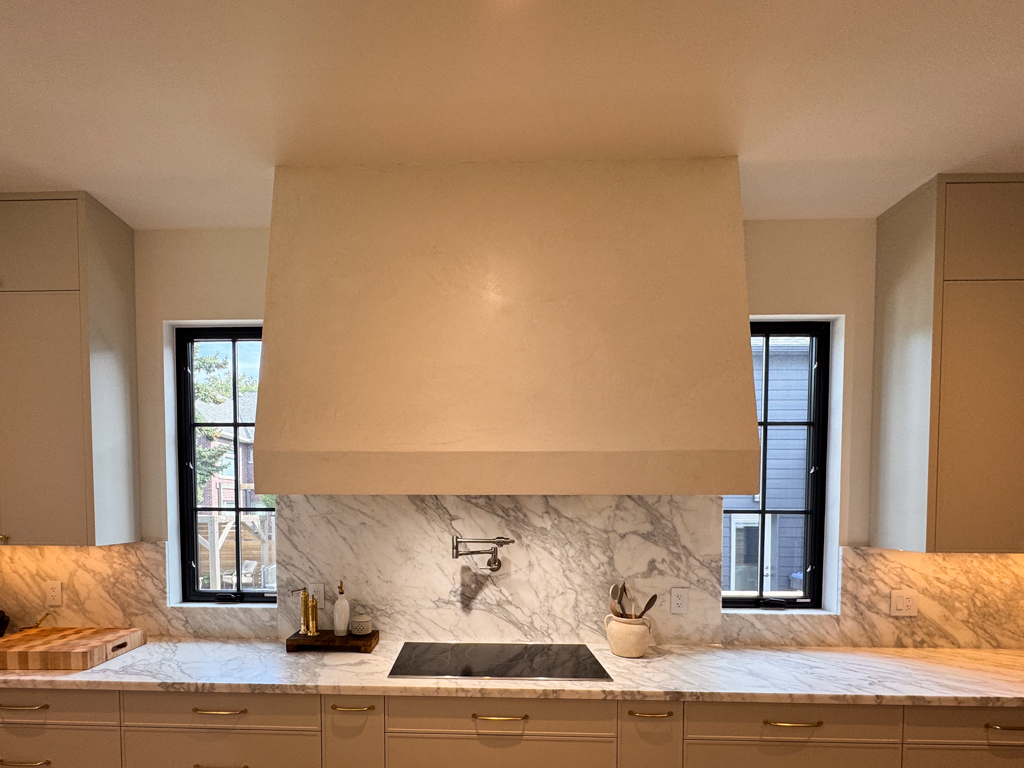
Completed Marmorino Venetian Plaster Kitchen Hood, Modern Minimalist
Speak To Shayan 416 (606) 8060 or Request A Quote
The Right Finish: Why We Chose Venetian Plaster
For a project this special, a simple painted surface wouldn’t suffice. The key was to introduce texture and depth while maintaining a clean, modern aesthetic. The two most popular choices for this type of finish are Venetian plaster and microcement, each with its own unique characteristics.
Microcement: This cement-based coating is known for its seamless, industrial appeal and incredible durability. It’s a fantastic choice for high-traffic areas and has superior resistance to moisture and cracking. For a sleek, modern, and almost concrete-like look, microcement is an excellent option.
Venetian Plaster: We ultimately chose Venetian plaster for this project, specifically a Marmorino finish, and here’s why. Unlike microcement, which can feel more modern and industrial, Venetian plaster has a rich history and a softer, more natural feel. Marmorino plaster, made with slaked lime and crushed marble dust, offers a nuanced, stone-like texture that feels authentic and luxurious. By choosing a finish with minimal burnishing, we were able to create a subtle, velvety sheen that perfectly captured the quiet elegance of the organic minimalist style our clients were after. The breathability and timeless character of Marmorino were the perfect fit for a space meant to be a natural, serene retreat
Microcement Installation for Kitchen Hood
For a project this special, a simple painted surface wouldn’t suffice. The key was to introduce texture and depth while maintaining a clean, modern aesthetic. The two most popular choices for this type of finish are Venetian plaster and microcement, each with its own unique characteristics.
Microcement: This cement-based coating is known for its seamless, industrial appeal and incredible durability. It’s a fantastic choice for high-traffic areas and has superior resistance to moisture and cracking. For a sleek, modern, and almost concrete-like look, microcement is an excellent option.
Venetian Plaster: We ultimately chose Venetian plaster for this project, specifically a Marmorino finish, and here’s why. Unlike microcement, which can feel more modern and industrial, Venetian plaster has a rich history and a softer, more natural feel. Marmorino plaster, made with slaked lime and crushed marble dust, offers a nuanced, stone-like texture that feels authentic and luxurious. By choosing a finish with minimal burnishing, we were able to create a subtle, velvety sheen that perfectly captured the quiet elegance of the organic minimalist style our clients were after. The breathability and timeless character of Marmorino were the perfect fit for a space meant to be a natural, serene retreat
Venetian Plaster Installation for Kitchen Hood
For a project this special, a simple painted surface wouldn’t suffice. The key was to introduce texture and depth while maintaining a clean, modern aesthetic. The two most popular choices for this type of finish are Venetian plaster and microcement, each with its own unique characteristics.
Microcement: This cement-based coating is known for its seamless, industrial appeal and incredible durability. It’s a fantastic choice for high-traffic areas and has superior resistance to moisture and cracking. For a sleek, modern, and almost concrete-like look, microcement is an excellent option.
Venetian Plaster: We ultimately chose Venetian plaster for this project, specifically a Marmorino finish, and here’s why. Unlike microcement, which can feel more modern and industrial, Venetian plaster has a rich history and a softer, more natural feel. Marmorino plaster, made with slaked lime and crushed marble dust, offers a nuanced, stone-like texture that feels authentic and luxurious. By choosing a finish with minimal burnishing, we were able to create a subtle, velvety sheen that perfectly captured the quiet elegance of the organic minimalist style our clients were after. The breathability and timeless character of Marmorino were the perfect fit for a space meant to be a natural, serene retreat
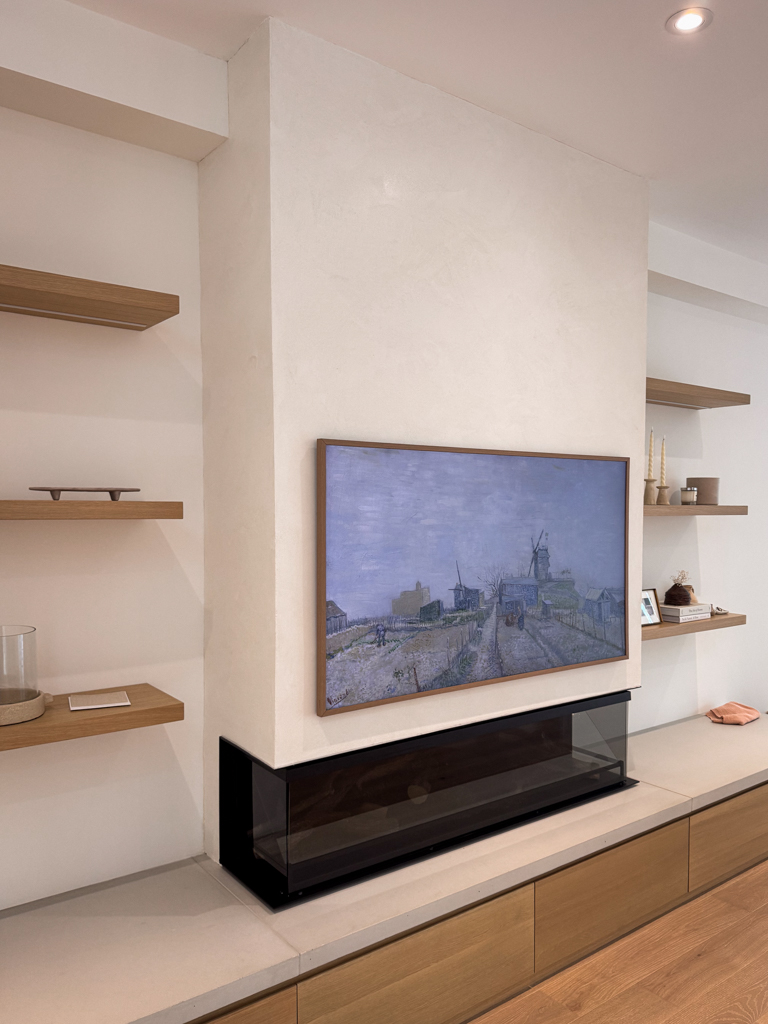
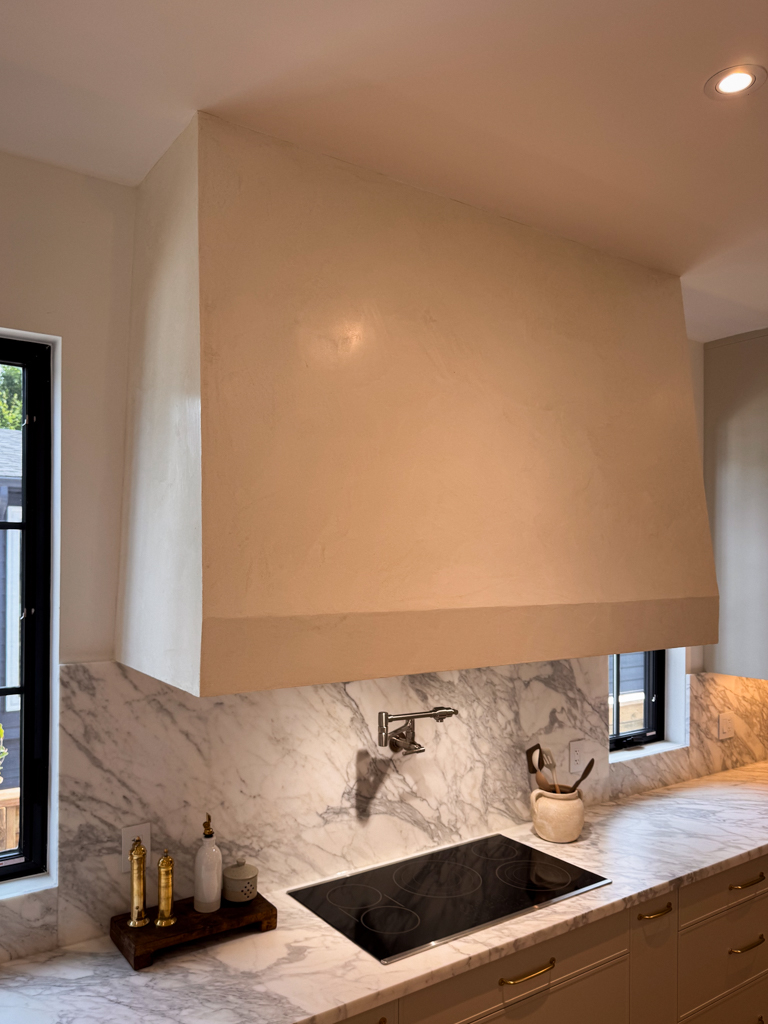
Kitchen Hood and Fireplace Surfaced with Venetian Plaster, Marmorino in Mississauga Residence
From MDF to Masterpiece: A Custom Kitchen Hood Transformed
The journey of the kitchen hood began as a simple MDF structure. To ensure a flawless and lasting finish, our artisans meticulously prepped the surface. This crucial first step involved installing corner beads and plastering over them to create a perfectly smooth canvas. This painstaking process not only guarantees crisp, clean lines but also provides a strong foundation that prevents future cracking, a common issue when plastering over seams or joints. With the smooth canvas prepared, the magic happened as our artisans meticulously applied multiple thin coats of the Marmorino Venetian plaster. This wasn’t just a simple application; it was a process that built a rich, textural finish from the ground up, with each layer adding depth and character. The final minimal burnishing created that “just right” amount of luster, highlighting the natural beauty of the marble-infused plaster without making the surface appear overly polished or reflective.
Venetian Plaster Kitchen Hood Application: From Start to Finish (Toronto, Woodbridge, Miami)
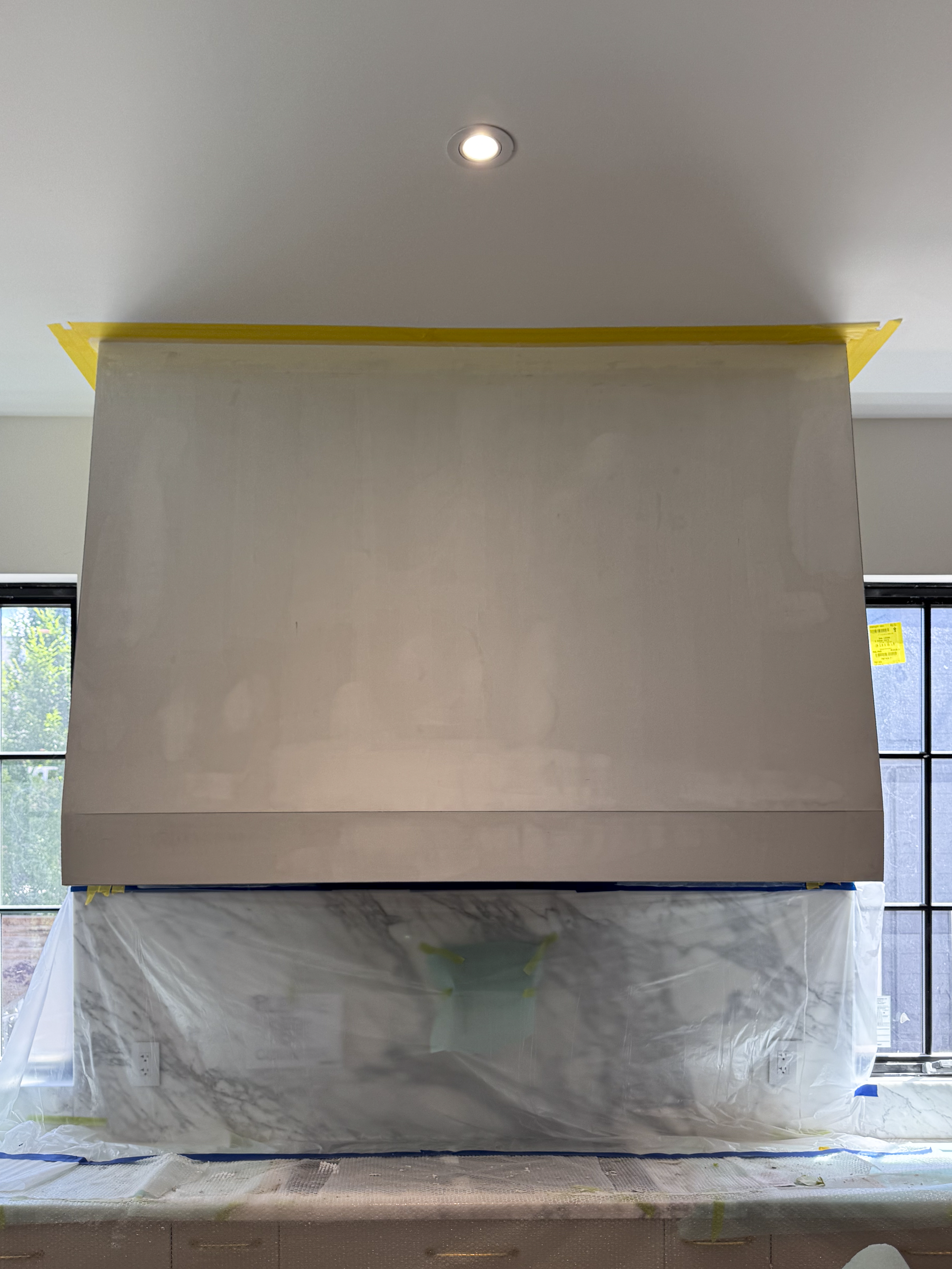
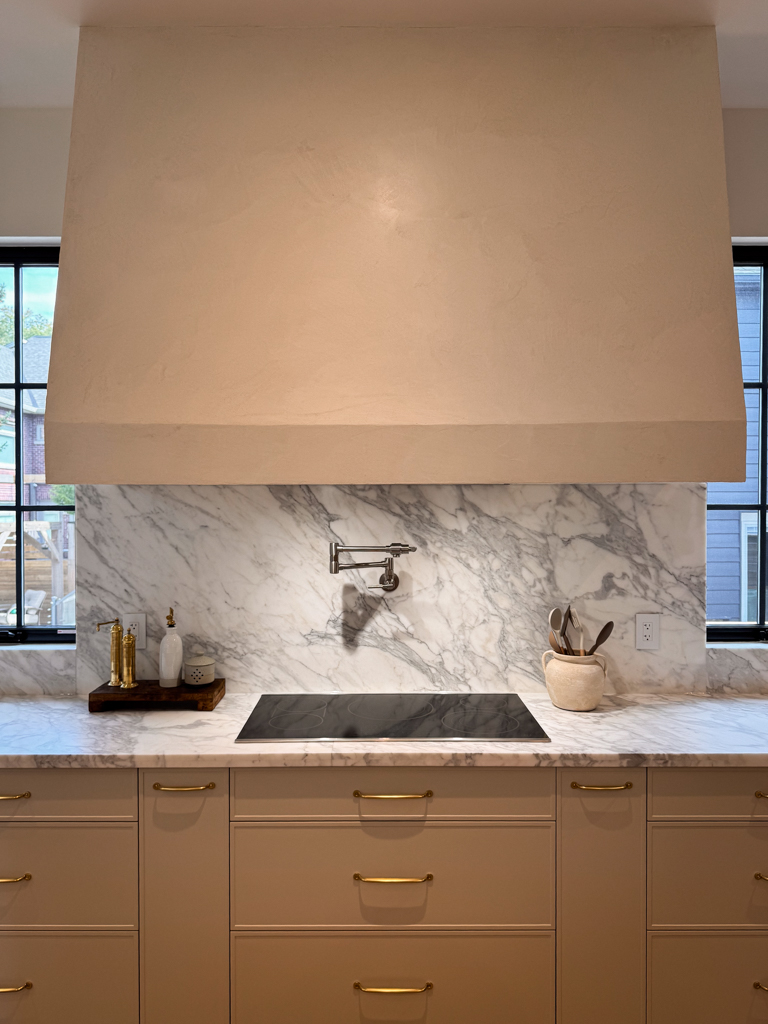
From MDF to Venetian Plaster, Marmorino: A Toronto Kitchen Hood Transformation
Venetian Plaster vs. Microcement: A Guide to Modern Minimalist Kitchen Finishes
The organic minimalist look is dominating kitchen design, and a key element of this trend is the use of textured, natural-looking finishes on focal points like range hoods and fireplaces. Two of the most popular choices for this are Venetian plaster and microcement. While they can achieve a similar aesthetic, their properties and applications are quite different. Here’s a breakdown to help you make the best choice for your Toronto, Etobicoke, Woodbridge, or Florida-area home.
We understand that choosing the right texture and color for your project is a crucial decision. That’s why we provide a complementary design consultation to walk you through our extensive portfolio and help you explore the perfect finish for your space. We’ll bring samples and discuss your vision in detail to ensure the final result is exactly what you’ve imagined.
FAQ: Venetian Plaster or Microcement for Modern Minimalist Design
Venetian Plaster Range Hood FAQ | Your Questions Answered by Toronto Pros
Whether you choose the timeless elegance of Venetian plaster or the modern durability of microcement, both options can transform your kitchen into a sophisticated, minimalist sanctuary. The best choice ultimately comes down to the specific aesthetic you want to achieve and the unique needs of your space.
Serving clients in Toronto, Jacksonville, and beyond!
Book a consultation session to explore our curated Venetian plaster and microcement samples.
Contact us today to get started with your kitchen range hood design.
Serving Toronto (Forest Hill, Yorkville, Rosedale, Kleinburg) and Florida (Jacksonville, Miami, Naples, Tampa)
| Toronto & GTA | |
|---|---|
|
|
| Jacksonville | Tampa | Miami | Broward County | Palm Beach County |
|---|---|---|---|---|
|
|
|
|
|




